Estate Jewelry: Masonic Orbs and Legendary Peacock Chokers
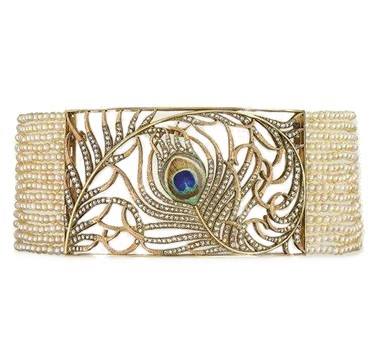
This stunning choker features a central peacock-feather-inspired plaque of gold, enamel and rose-cut diamonds, supported by fourteen strands of pearls. It’s a close relative of this equally stunning piece in the Smithsonian, and was created by the one of the oldest jewelry houses in the world.
Mellerio dits Meller are currently into their fourteenth (!!!) generation as jewelers. Established in Paris in 1613, they moved to their current location on the rue de la Paix in 1815, and opened a branch in Madrid in 1850. They got their start when Jean-Marie Mellerio — a chimney sweep with good hearing — helped warn Marie de’ Medici of a plot against her son, King Louis XIII. In return, he was rewarded the royal privilege to sell small goods, crystal, and other trinkets, which the family eventually spun into a trade in jewelry and other luxury items. The privilege was renewed by the next three kings, and since then their jewelry has continued to be favored by royalty. They are particularly renowned for their shell tiara, which was bought by Spain’s Queen Isabella II in 1868 for her daughter, the Infanta Isabella. Members of the Spanish royal family still wear the piece today.
The family also inspired literature: in 1873, Robert Browning based his poem Red Cotton Night-Cap Country, or Turf and Towers, on the true story of the death (suicide?) of Antoine Mellerio.
Note: This is unrelated to Mellerio, but the choker has reminded me to show you this fantastic article from 1897, which describes how the extraordinarily long neck of one of our greatest exports, Consuelo Vanderbilt, led to much envy and photographic trickery in late 19th century London. Also, if any of you have a “Consuelo throat” and a decent amount of cash, you may be interested in the jewelry of Marina J, who creates beautiful chokers by pairing antique brooches with pearls.
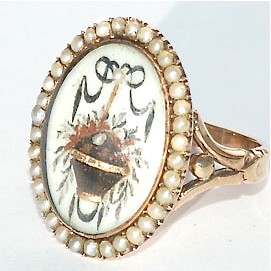
So often we see Georgian rings that represent loss, but, happily, this one might be about love. Depicting a basket of roses in sepia and hairwork on ivory, and surrounded by seed pearls set in gold, it would possibly have been given as a “token of affection,” according to the dealer, because roses were classically associated with Venus, the goddess of love (or Aphrodite, if you want to be all Greek about it). Crimson roses also symbolize deep mourning, but that may be more of a Victorian view, so let’s go with the happy interpretation for a change.
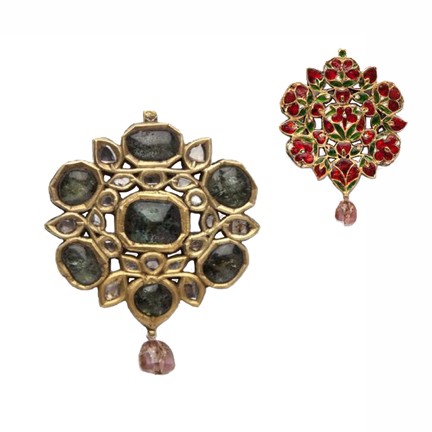
This pendant dates to the 18th century and comes from Jaipur, in Northern India. The dark stones are cabochon emeralds, with foiled backs — which makes the emeralds appear darker, but also helps to reflect light up through them — and flat-cut diamonds. The piece is beautiful as is, but I’ve said before that my favorite thing about Indian jewelry is that the backs of the pieces are just as beautifully finished as the fronts, and the back of this particular piece features an opulent floral motif enameled in bright reds and greens.
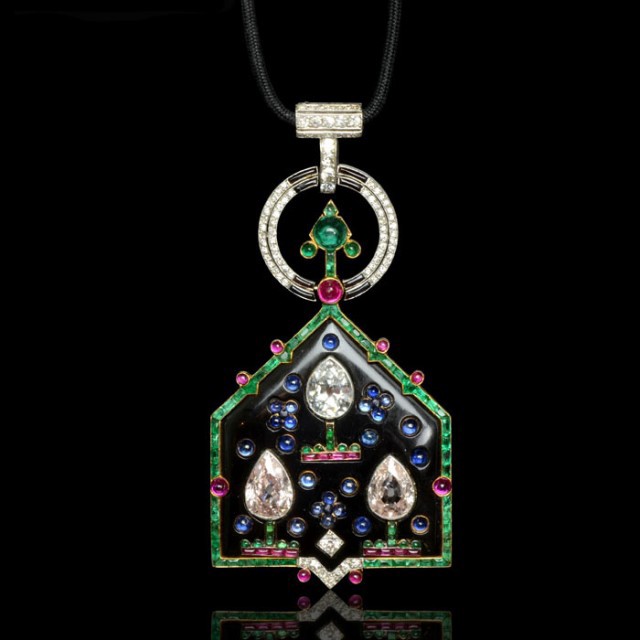
When a piece of jewelry is rare, or of exceptional quality, or just plain extraordinary, it is called “important.” So when the dealer describes a piece as “highly important,” you know it’s pretty good.
By Cartier, this pendant is an excellent example of Art Deco, combining sleek, geometric design with a ton of color and a strong Indian influence. It dates to 1921, and the original design is by Cartier chief designer Charles Jacqueau. Jacqueau was known for pairing both high- and low-end materials in the same piece — as is seen in this pendant, in which diamonds, emeralds, sapphires and rubies are set into an onyx plaque that is surrounded by a border of emerald. The black onyx background sets off the both the color of the precious stones and the brightness of the three pear-shaped diamonds, and an emerald-set arrow connects the plaque to two circles of diamond and onyx. The pendant hangs from a black silk cord, another Jacqueau hallmark.
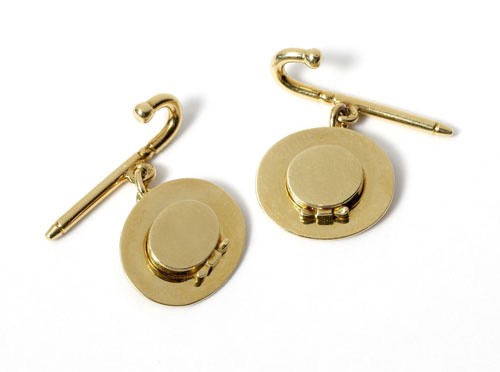
These yellow gold cufflinks were a Christmas gift from the great French actor and singer Maurice Chevalier to his pianist, Fred Freed. Taking the form of a straw boater hat and cane — which Chevalier made famous in the film Can-Can — one of the cufflinks is engraved with the words “a Fred” and “Maurice,” while the other states “Noel” and “1953.” They’re French (of course). (Note: the Wartski site does not link to specific items, so got to “Jewellery,” scroll down, and you’ll see these cufflinks in the middle, about halfway down the page.)
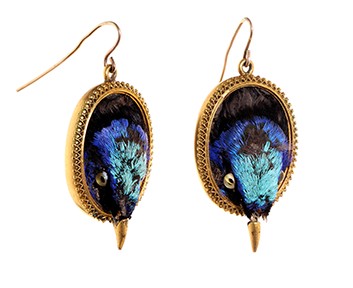
I’ve featured a Victorian taxidermy hummingbird brooch in the past, but now here’s a pair of earrings. Circa 1860–70, they’ve been set low into their gilt frames to showcase the beautiful coloring of the birds. The Victorians were fascinated with natural history, and they weren’t squeamish about displaying or wearing actual specimens of birds and beetles — and some of them were even living. I used to work for a jewelry trade magazine that dated back to 1869, so naturally I trawled through their past issues at every opportunity. I found this little tidbit in the “Trade Gossip” section of the July 1879 issue of the magazine (which was then called The Jewelers’ Circular and Horological Review): “A young lady living on Murray Hill has a singular pet and ornament. It is a live Brazilian beetle with spots like brilliant diamonds. A gold chain harness has been made for it. One end of the tether is fastened to the shoulder of the lady’s dress and the beetle disports himself on the fair parade ground so far as the chain will permit.”
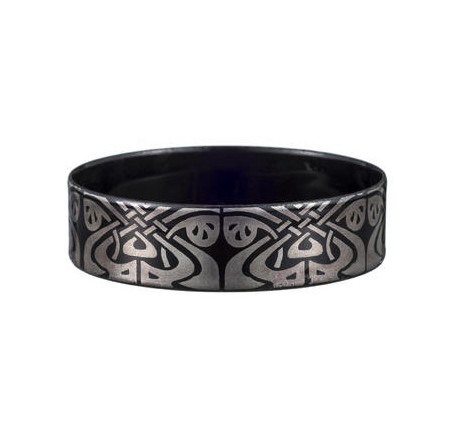
This bangle dates to 1910, and features a classic Art Nouveau pattern in sterling silver and enamel. The simple, streamlined silhouette saves the piece from being too fussy. Gorgeous.
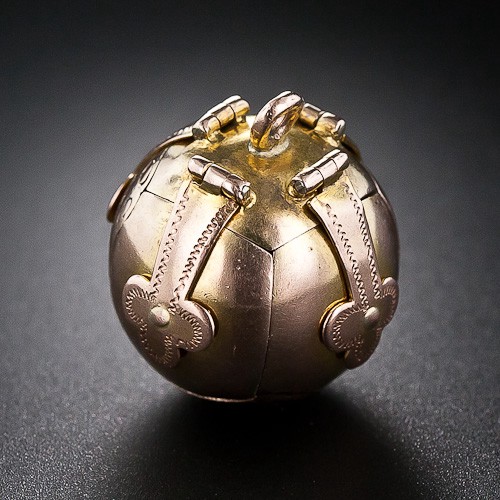
I love these Masonic orb pendants — they’re ingeniously constructed to unfold into the shape of a cross, with six pyramids (which represent knowledge and wisdom) engraved on all four sides with mysterious symbols. They were most often worn during the late 19th or early 20th century as watch fobs, and this one — which is British, and 9k gold — dates to that time period.
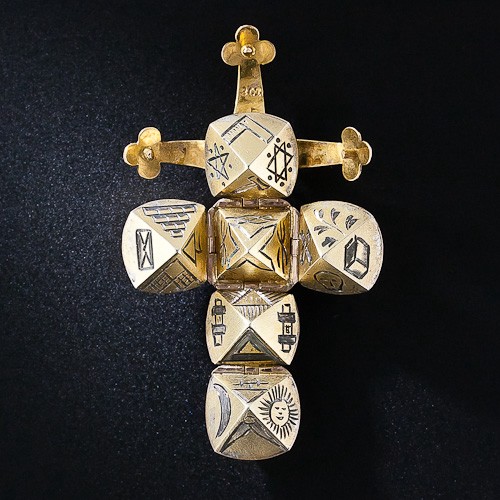
The orb’s shape is symbolic of the earth, but it also resembles a “ballot ball,” which was used during Masonic voting. According to my 1884 copy of The Encyclopedia of Freemasonry (everyone should have one), “In the election of candidates, Lodges have recourse to a ballot of white and black balls. Unanimity of choice, in this case, is always desired and demanded; one black ball only being required to reject a candidate.”
The images engraved on the pyramids are also key Masonic symbols, including the square, the gavel, and the six-pointed star. (More info on the symbols can be found here.)
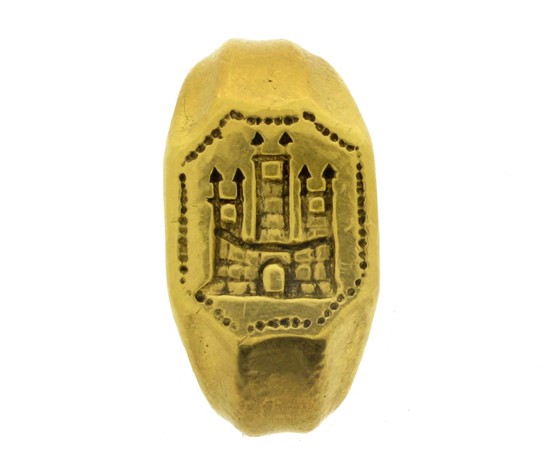
This heavy (45.61 grams!) old ring dates to the 15th century. It’s a sheriff’s ring, and is designed as a signet ring, with a depiction of three turreted castles engraved in yellow gold with a dotted border. It would have been used to seal documents, as sheriffs were appointed to each county in England as officers of the King, and charged with carrying out his administrative business and generally keeping the peace.
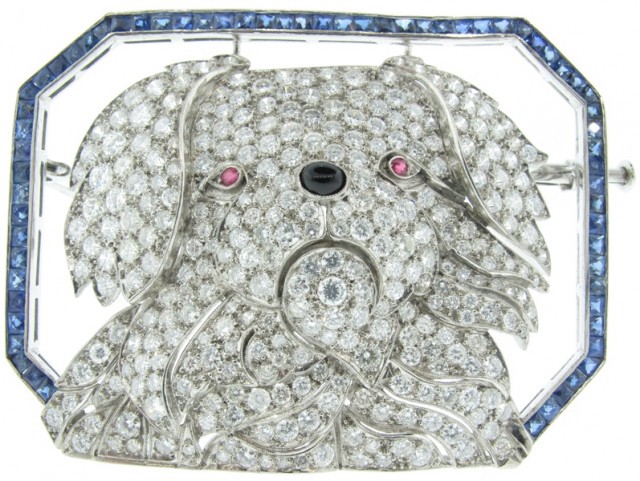
The canine equivalent of Grumpy Cat, this diamond and sapphire pin by Janesich, circa 1925, features 12 carats of diamonds and 4 carats of sapphires. Janesich, a high-end jewelry firm that was founded in Trieste in 1835 by Leopoldo Janesich, maintained branches in Paris, London, Monte Carlo, and some other ritzy spots during its heyday. The company was renowned for a skillful use of the Art Deco style, and the shops were patronized by various members of European royalty.
Janesich saw tough times following World War II and eventually scaled back, but the company is still in Trieste, being run by sixth-generation family member Francesco Janesich. You can learn more about its background and view some gorgeous old jewels here.
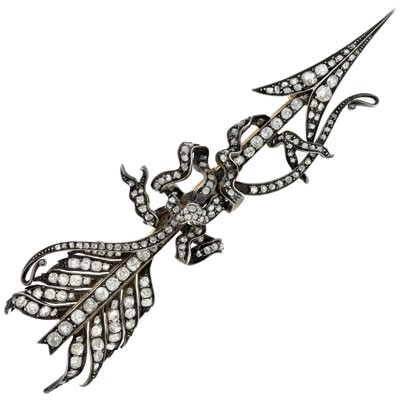
This Victorian arrow pin is huge — almost 5 ½” long! — and features diamonds set into sterling-topped 15k gold. The design, which features a naturalistic depiction of feathers as well as an intricate ribbon design, totals 9.45 carats of old rose- and old mine-cut diamonds.
Previously: A Necklace That Wears Its Own Rings
Monica McLaughlin wants to mention that there are a couple of interesting jewelry-related events coming up in March. First, the exhibit “Out of this World! Jewelry in the Space Age,” will showcase outer-space-related designs from the Georgian era up to today, and opens at the Forbes Galleries in New York on March 16. It will run through September 7.
And on March 24, the engagement ring that Napoleon gave to Josephine will be auctioned at the French auction house Osenat. No photos or auction catalog available yet, but the ring is said to be very simple, with a diamond and a pear-shaped sapphire set in gold.